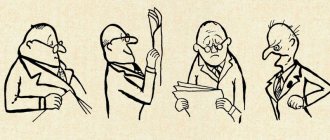Hello, friends! Lyudmila Redkina is with you, and today I want to share with you techniques that will help you “read” a person as soon as you see him. Is it really a good skill? And it turns out that this is not difficult to learn. Many people probably know the series “Lie to Me,” where the main character recognized a lie by his smile, body position, and openness of his eyes. When I watched it for the first time, I was impressed and I myself wanted to expose everyone in the same way. So, today we are talking about how to recognize a lie, what you need to know and do to do this.
COMPLETE LIST OF HUMAN SKILLS
How to recognize a lie between a woman and a man during a conversation by facial expressions, gestures, eyes: the theory of lies
First of all, lies are manifested in a person’s facial expressions.
In order to recognize a liar, look carefully at your interlocutor. If you see the following signs in his facial expressions, then he is most likely a liar.
- Asymmetry. This symptom can manifest itself in different ways. Firstly, one side of the interlocutor’s face may express an emotion more strongly. That is, on the face on the right or left, the muscles will be more tense.
- Time . If during a conversation the interlocutor’s facial expression changes after just 5 seconds, then this is a pretense. Scientists have found that usually a change in facial expressions occurs on average after 10 seconds. However, if your interlocutor is experiencing rage, delight or depression, then his facial expression changes really quickly.
- Inconsistency between emotions and words. If your interlocutor verbally expressed any emotion, but his face is still calm, then he most likely deceived you. It's the same with the delayed expression of emotion. For example, if a person says how sad he is, but the sadness on his face appears late, then he wants to mislead you. Sincerity is manifested in the synchronicity of words and emotions.
- Smile . A smile can also often appear on the interlocutor’s face when he is deceiving you. There are two reasons for this. A person is accustomed to using a smile to relieve tension. This is a kind of instinct that appears in childhood and persists until adulthood. And since when a person cheats, he experiences stress, a smile helps him relieve stress. Another reason why liars often smile is in others. Joy helps hide their true emotions.
However, when trying to spot a liar by their smile, be careful. Scientists have found that during conversations, liars and ordinary people smile with the same frequency. Only their smiles are different. A liar's smile can be called "strained." She looks tense and her lips are pulled back slightly, slightly showing her teeth.
Also, a lie can be easily noticed in the eyes of the speaker.
If the other person is honest with you, he will look you in the eye most of the time. However, a liar will prefer to avoid eye contact by any means necessary. But be careful, an experienced liar, on the contrary, will try to look at you as often as possible during a conversation. If an honest person can look away a couple of times when remembering or imagining something, then an experienced liar will still make eye contact in these cases.
Simply put, during a normal conversation, eyes meet about 2/3 times during the entire conversation, while when talking with an inexperienced liar, eyes will meet a maximum of 1/3 times during the entire conversation. When the conversation returns to what the liar is trying to hide, his gaze will immediately turn to the side. This way, the liar will try to focus on coming up with the most plausible answer.
Pay attention to the pupils of your interlocutor. If they have expanded, then he is lying. At the same time, the liar’s eyes sparkle. All this comes from the stress he experiences. It’s interesting that men who are liars usually look down, while women who are liars, on the contrary, tend to look up.
Observing body language is a great way to spot a liar. Here are some gestures and their features that are signs of lies:
- Stiffness. The interlocutor's gestures are awkward and stingy. He moves and gestures little. This does not apply to modest people, who always tend to behave this way.
- Scratching. A liar will often be nervous and because of this, he will often involuntarily touch his nose, throat, area around the mouth, and also scratch behind the ear.
- Nervousness. A liar often bites his lips, tries to distract himself from the conversation and smoke. Also, his gestures will be very nervous, his gestures will be abrupt.
- Hands. If a person constantly brings his hands to his face, as if trying to close himself off from you, this is a sure sign that he is lying to you.
- Mouth covered with hand. A liar involuntarily tends to cover his mouth with his hand, sometimes while pressing his thumb to his cheek. Sometimes this is accompanied by coughing. It’s as if the person is trying to cover his mouth in time so as not to let it slip. And the cough is designed to distract you from the topic of conversation. After all, if you are polite, you can ask if the interlocutor is healthy. And thus you will be distracted from the real topic of conversation.
- Touching the nose. This gesture may be a continuation of the previous one. The whole point is that the liar, having caught himself with his hand reaching for his mouth, tries to correct himself and pretends that his nose is just itchy.
- Ear cover. Some liars try to subconsciously distance themselves from their own lies. At such moments, the hand is located next to the ear or even covers it.
- Through teeth. Sometimes, in order not to let it slip, a liar subconsciously clenches his teeth when talking. But it can also be a common sign of dissatisfaction. Before deciding that this is a gesture of lying, think about the situation the interlocutor is in.
- Touching the eyes. This gesture is slightly different for men and women. The woman seems to be trying to fix her makeup by running her finger under her eye. And men just rub their eyelids. This is another way to avoid eye contact. But this gesture also has two meanings. The first, as we already know, is a lie. And the second is fatigue from the conversation and the desire to show the interlocutor how tired of looking at him.
- Scratching the neck. This gesture most often looks like this: a person begins to run his hand along the side of his neck or scratch his earlobe. Most often, this gesture is repeated several times and the number of repetitions reaches 5 times. This gesture demonstrates the liar's doubts. For example, you told a person something, and he replied: “Yes, yes, I understand” or “I agree,” and at the same time scratched his ear or neck. This shows that he actually doubts your words or simply did not understand you.
- “Something has become stuffy.” When a person lies, he gets excited and sweats a lot. Because of this, he sometimes becomes hot, and he begins to pull at the collar of his shirt or sweater, as people do in extreme heat. With this gesture he tries to distract himself from the conversation that worries him. But be careful, if your interlocutor is angry or upset, with this gesture he may be trying to come to his senses and cool down. How can you understand what state your interlocutor is in? Is he simply holding back his emotions or lying? The surest way is to ask him again. At the same time, the liar will most likely hesitate and remain silent for a while, trying to understand whether you saw through his lie or not. And an excited or angry person will immediately repeat what was said, while his voice will tremble or his facial expressions will show his feelings.
- Baby gesture. Liars often subconsciously put their fingers in their mouths. So they try to get rid of the feeling of guilt and move back to a time when everyone cared about them and looked after them. This is how a liar seeks your help and forgiveness. It’s as if he’s trying to say: “Yes, I’m lying, but I’m so harmless and I’m ashamed, so don’t be angry, please.”
Types of lies
A lie is any false information communicated by one person to another. Often people lie completely in vain. They distort the truth, try to embellish it, or suppress important details. Although there is no need to lie.
Depending on the goals pursued by the “liar,” the following types of lies can be defined:
- Unconscious. Being under the influence of strong emotions, a person does not realize that he has embellished part of the story with unreliable facts. Very often, young children lie unknowingly simply because they are not yet able to remember a large amount of information and resort to the help of their wild imagination.
- Deliberate. In this case, the person is well aware that he is lying in pursuit of his goal. Deliberate lies are not always used to achieve any selfish goals. It happens that people deliberately hide the truth, wanting to protect their loved ones. This is the so-called white lie. When, for example, someone hides their serious illness from relatives so as not to cause them suffering.
- Active. This is a type of deliberate lie that does not have a clear purpose. A person simply invents events that did not actually happen to him. Most often, this is done in a conversation with unfamiliar people in order to seem like a more interesting and intelligent interlocutor.
- Passive. Such lies manifest themselves in the suppression of facts. For example, a man who has been in a relationship with a woman for a relatively short time is in no hurry to tell her that he is married and has children.
- Pathological. This type of lie is characteristic of people with low social status. They invent a whole life for themselves in which they occupy a high position or have a noble origin. At the same time, the liar himself sincerely believes in it.
The most common reason for lying is fear. A person who deceives others, but does it unprofessionally, can be easily recognized by his facial expressions and gestures, and by his eyes. They will signal that he is scared.
How a person behaves when he lies: psychology
While observing your interlocutor, pay attention to the left half of his body. The reason is that it is the left side of the body that is responsible for emotions. So if you want to understand whether a person is telling the truth, look at his left hand, half of his face or leg. Our brain controls the right side of the body most. And the left is often beyond our control. The fact is that even if a lie is invented in advance, a person thinks most of all about his words, and not about emotions and gestures. Therefore, the left side, which is most associated with emotions, can give away his true feelings and intentions.
For example, if a liar is nervous, his left leg or arm will involuntarily sway back and forth. The left hand will make strange circular gestures, and the left leg may begin to draw strange signs on the asphalt or floor.
Researchers have found that each hemisphere of the body controls its half of the body. The right hemisphere is responsible for emotions, feelings and imagination. And the left is for intelligence and speech. Nature has arranged it so that each hemisphere controls the “opposite” part of the body. That is, the left hemisphere controls the right part of the body, and the left, on the contrary, controls the right.
That is why it turns out that it is the right side of the body that lends itself to more conscious control. This is the reason for one of the main signs of a liar - asymmetry, when the right side of the body tries to remain calm or express the “correct” emotion, and the left side of the body contradicts this.
Important clarification
Before you accuse someone, take a closer look at their behavior. If a person constantly sends the signals listed above, it is not at all necessary that this is a pathological liar. Perhaps he is simply fidgety by nature or suffers from ADHD (attention deficit hyperactivity disorder).
The situation can be the opposite: someone is lying to you, but does not show the described signs. Psychopaths may behave this way because they do not feel guilty or bothered by the deception. Fortunately, we can calculate them too.
How to recognize lies in correspondence, text messages, over the phone?
During correspondence, it is especially easy to hide the truth, because we cannot hear the voice of the interlocutor or see his face. Most often, people lie about their plans. Situations are especially common when someone promises that they will be “in 5 minutes”, but at the same time is half an hour late. In addition to such situations, according to research, only 11 percent of messages contain deception and only 5 people out of all 164 subjects turned out to be real liars, and half of their correspondence was deception. So meeting a habitual liar on social media. networks are not easy. Here are a few signs that will help you identify such a person, or simply figure out that your interlocutor is not telling something.
- Using the words "that woman" or "that man" . By talking about someone in this way, the interlocutor is trying to hide the fact of intimacy or deliberately reduce the significance of this person in his life.
- If your interlocutor told you about many unusual events in his life , and you doubt their veracity, do the following. After some time, ask the person to talk about the same incidents, but in reverse order. For example, your pen pal told you a long story about how he went to visit his millionaire uncle. After a couple of days, ask him: “Excuse me, remember you told me about your uncle? So how did it all end? Big party? What happened before that? I forgot something...” This is a joke example. But the method works. After all, a liar, after some time, will forget about the sequence in which he lied and will definitely mix something up.
- Too many little things . If a person talks about some long-ago event in numerous details, then most likely he wants to deceive you. Agree, we sometimes don’t remember in detail what we did yesterday. And if a person remembers almost every minute of some last year’s event, then something is clearly wrong. Most often, a liar will use an overly detailed story about something to give you the illusion that what he is saying is true.
- Half-truth . Sometimes people only talk about part of their life. If he is a man, he may only talk about the positive aspects of his life to impress you.
- Excuses and slurred speech . In this case, the liar does not give a direct answer or begins to answer using vague or abstract expressions. The words “maybe”, “somehow”, “we’ll see”, “time will tell” are also used for excuses. This situation often arises when one of the interlocutors on social media. network gives advice to another. And this person does not want to follow the advice, but in order not to offend the interlocutor, he makes a vague promise that contains the words given above.
Language of the body
Sweating.
It was said above that this sign is not always correct, but statistics inexorably assert: a person who lies sweats more than a person who is truthful.
Head nods.
As a rule, we nod involuntarily to confirm our words or agree with what was said. When a person lies, there is a delay between the words and the nod of the head.
Fussiness.
The thief's hat is on fire. General fussiness, nervousness, inability to sit still, unnatural posture will be a good help in determining the veracity of a person’s words.
Movements.
A person who tells the truth leans towards the interlocutor, a liar, on the contrary, moves away.
During communication, many people unconsciously use mirroring -
they repeat the gestures of their counterparts. When a person lies, this subconscious reaction is suppressed. Restless hand position (smoothing hair, adjusting a tie, wanting to squeeze something) also reveals a liar.
Swallowing saliva and breathing.
Increased breathing may indicate that a person is on thin ice. He begins to breathe faster in order to pump his brain with oxygen, which is necessary for orientation in a critical situation. Excessive saliva production is associated with the release of adrenaline, so frequent swallowing can reveal a liar.
Don't you like it when people bully you? It's time to learn about methods of exposing liars.
Still from the film “The Day the Earth Stood Still”
All people lie. Some more often, some less often, and even the most honest person can involuntarily lie without noticing it. This feature of human nature forces us to be on guard and check almost any information. Even the most reliable one. But most of all, we lack the skill of understanding that they are lying to you right during a conversation.
Therefore, to make it difficult to deceive you, we have prepared the main tips and life hacks, based on which you can easily spot a liar.
Reviews and comments
Once again, don't get too carried away with spy games and be objective in your assessments. You can discuss practical issues related to the use of techniques to determine a person’s veracity using the form below.
We also recommend reading:
- Storytelling
- Verbal signs of lying
- Microexpressions
- Books on profiling
- 3 Eco-Friendly Ways to Get What You Need from Someone
- Is it easy to spot a lie?
- “Pinocchio effect”: don’t lie – you’ll freeze!
- Identifying Cheating with Six Questions
- Lie detection methods
- How to leave a good first impression. Secrets of Leila Lowndes
- The Brokaw Trap and Lie Detection
Key words:1Profiling











